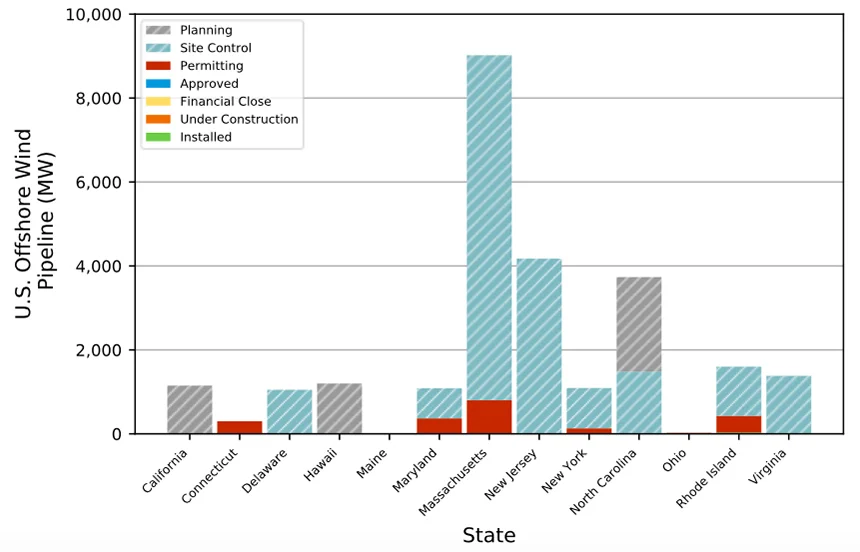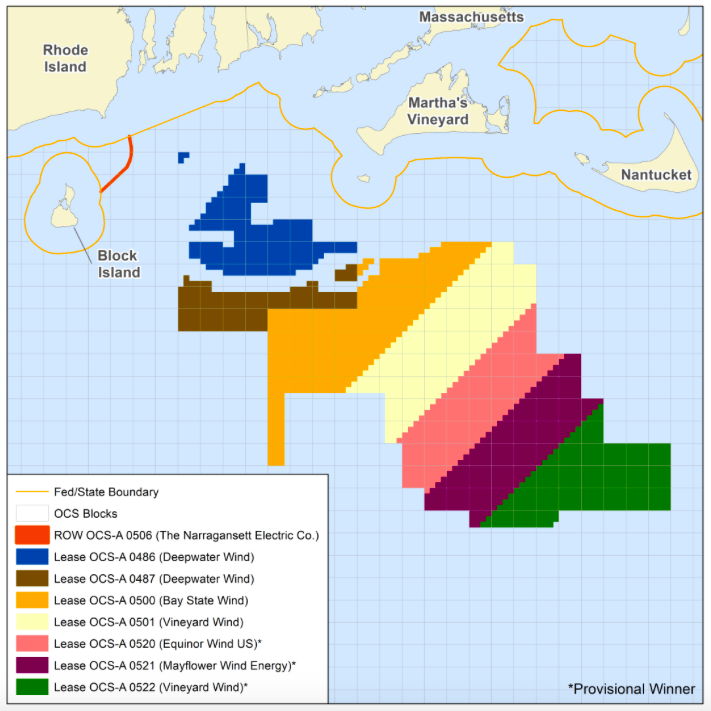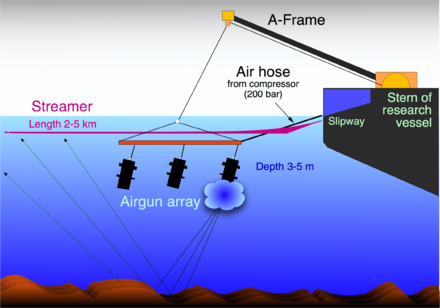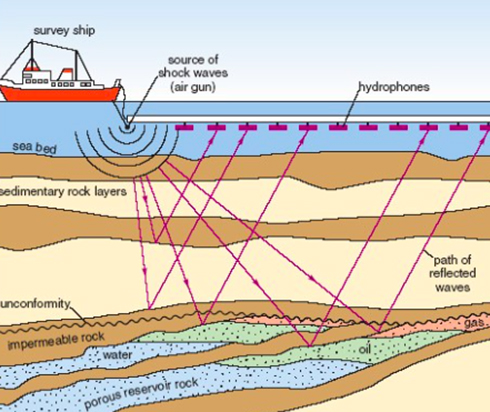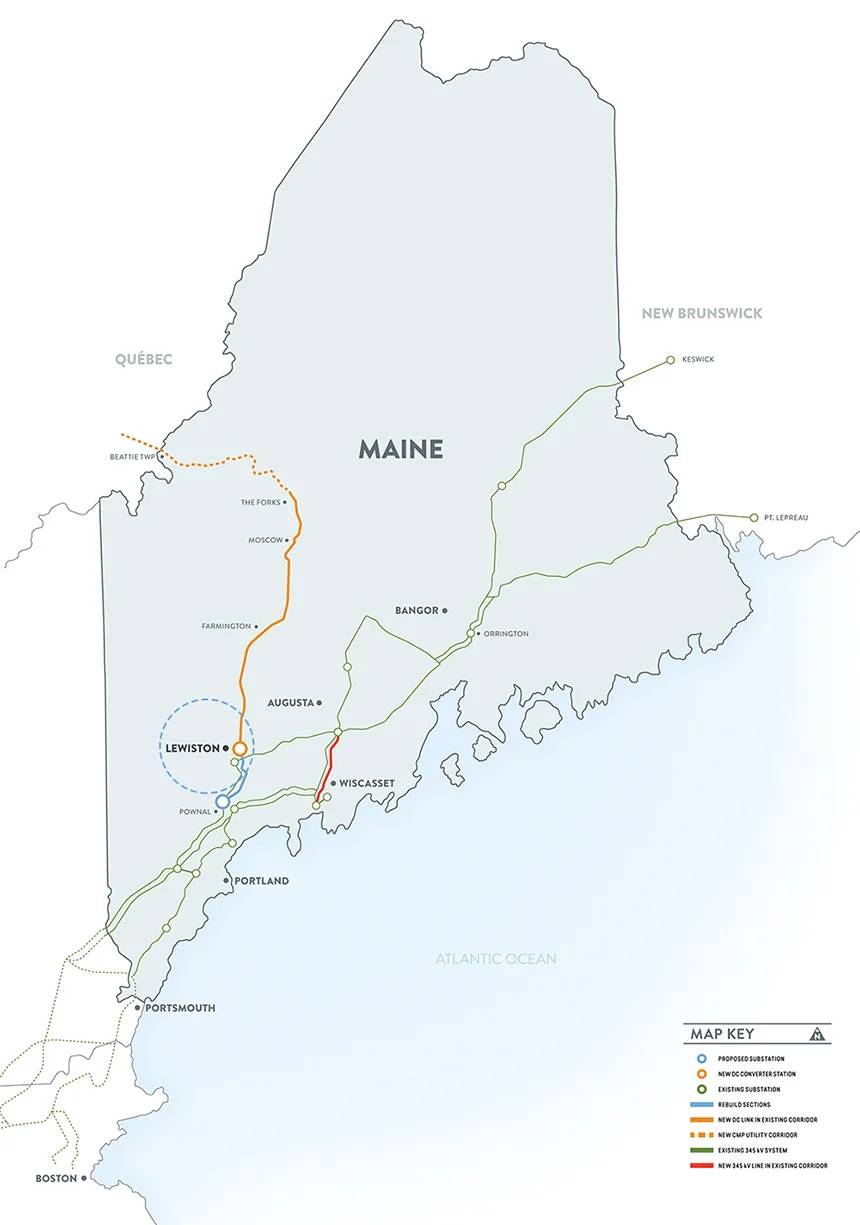From ecoRI News (ecori.org)
The recent announcement by Ørsted and Eversource to invest $24 million in an assembly facility at the Port of Providence is a shot in the arm for local jobs and sign of the financial tidal wave flowing into the offshore wind industry.
The infrastructure pledge is part of $40 million the energy companies plan to spend on ProvPort and the Quonset Business Park in North Kingstown, R.I. The facilities will create at least 40 jobs and support construction for the Revolution Wind and South Fork Wind offshore facilities. Quonset, with a federally funded pier expansion, will host a boat building company with plans to make two crew-transport vessels, and serve as the transmission cable landing for at least two offshore wind projects.
A third facility, at the State Pier in New London, Conn., will receive an additional $77.5 million from Ørsted and Eversource to build a deep-water cargo port. The pier project creates 460 construction jobs and offers faster access to the Revolution and South Fork wind facilities and a third Ørsted/Eversource project, Sunrise Wind.
Lured by generous subsidies and billions from power-purchase contracts, international utilities and even major fossil-fuel extractors are surging into the region to embrace the advancing renewable-energy boom. The United States currently has more than 29,000 megawatts of offshore wind procurement targets.
In the next five years alone, offshore wind developers plan to bring online 9,100 megawatts from 13 offshore wind projects.
A pro-wind administration and new federal incentives are stoking the growth. The December 2020 federal stimulus package included a new 30 percent tax credit for offshore wind projects. In March, the Biden administration sweetened investments for offshore wind development by opening a new lease area off New York and New Jersey. There’s $3 billion for new loans, and funds for more port construction, and research and development.
Developers such as Ørsted and Vineyard Wind aren’t spending for free. Fueled by long-term contacts and sales of renewable-energy credits, both paid by ratepayers, developers and financial institutions like JPMorgan Chase and Goldman Sachs stand to make many times what is being spent on port development and infrastructure investments.
Ørsted, the world’s largest offshore wind developer, is looking at an estimated $3.2 billion in revenue from the power-purchase agreement for Revolution Wind alone.
While they fight for the right to continue to belch out greenhouse-gas emissions, fossil-fuel behemoths are also becoming interested in renewable energy. Big banks are financing projects on both sides. (istock)
Fossil-fuel fingerprints on renewables
Drawn by lucrative fixed-pricing contracts that guarantee a revenue stream, oil and gas developers and bankers are profiting from the response to a problem they had a hand in creating. Fossil-fuel giants such as Chevron and Royal Dutch Shell are embracing offshore wind as new players in the growing sector.
“Every barrel of oil and every watt of electricity that the women and men of the U.S. offshore sector produce is energy that our nation does [not] have to import from state-backed producers in pollution havens such as Russia or China,” according to Erik Milito, president of the lobbying firm National Ocean Industries Association, whose members in the convoluted energy sector include ExxonMobil, Halliburton, ocean rare earth mineral miners, and Ørsted.
Many of the big banks financing these projects, such as JPMorgan Chase, Citi, and Bank of America, are still funding fossil-fuel development. Chase, the top lender, has financed $317 billion for fossil-fuel ventures since the Paris Agreement was signed in 2016. Some like ExxonMobil and Shell are facing legal battles for climate denial and for failing to protect their behemoth waterfront oil and gas terminals from the climate crisis.
But Ørsted, previously named Danish Oil and Natural Gas, was a full-fledged fossil-fuel extraction and distribution company that owned oil, gas, and coal power plants. In 2009, the company publicly pledged to transition to offshore wind and is now leading the offshore “green revolution.”
Although Copenhagen was the site of the United Nations’ climate conference that year, public pressure had little to do with the multinational’s transition to renewable energy. According to the online magazine Corporate Knights, Ørsted’s shift to wind was mostly made in reaction to declining revenue, as fossil-fuel profits dropped and the costs to build renewables declined. Ørsted’s stock price and growing earnings reflect the fiscal gains of that decision, serving as a nautical map to offshore wind for other utilities to follow.
While 90 percent of public testimony delivered in Massachusetts legislative committees on energy and climate change favor climate and renewable-energy bills, special interests push back hard. (Climate Social Science Network)
Financial gains flow away
Like most privately owned U.S. utilities, National Grid and Eversource are keeping stakes in fossil fuels. The companies still own natural-gas infrastructure and distribution networks. Eversource, however, appears to be following in Ørsted’s footsteps by branching out into offshore wind generation.
In 2019, the Hartford-based utility bought a 50 percent stake in Revolution Wind and South Fork Wind, plus joint ownership of a lease of a 300-square-mile ocean wind area.
National Grid isn’t staying on the renewable-energy sideline. The United Kingdom-based utility is building and profiting from undersea transmission cables for the Revolution Wind project. The utility is writing the request for proposal (RFP) for another 600 megawatts of offshore wind power for Rhode Island, a project the utility stands to profit from.
Meanwhile, at statehouses across the country, private utilities lobby against environmental legislation, especially solar bills that benefit decentralized ownership.
According to a recent report by the Brown University-based Climate Social Science Network, the two primary utilities in Massachusetts, National Grid and Eversource, often sided with real-estate and fossil-fuel organizations by opposing legislation that addresses the climate crisis, while supporting bills that promote imported, large-scale hydropower and local offshore wind energy.
“These projects would result in substantial contracts for the state’s largest utilities,” according to the 36-page report. “Conversely, solar electricity is often decentralized on residential and commercial rooftops and therefore ‘behind the meter,’ meaning it cuts into electric utilities’ revenues.”
In recent years, National Grid has resisted moratoriums on natural-gas connections and locked out union workers over contract disputes.
In a new scandal, Rhode Island’s main gas and electric utility is being accused of reaping millions from an excessive surcharge related to its undersea cable for the Block Island Wind Farm. The discovery prompted Rhode Island Public Utilities Commission (PUC) chairman Ronald Gerwatowski, during a recent PUC meeting, to declare, “they’re making so much money on this that it’s ridiculous. … The company should be ashamed of itself.” (His comments start at about the 1:54 mark.)
While benefits like port development, fisheries research, and engineering and construction jobs are significant to Rhode Island and the region, they pale compared to the billions heading to investors.
The revenue streams are complicated, but a major slice of the financial gains are flowing out of state to foreign-owned banks and energy institutions such as National Grid, Ørsted, and their shareholders. Vineyard Wind is co-owned by a Danish investment firm and Iberdrola, a Spanish multinational utility that also owns coal power plants.
The 804-megawatt Mayflower Wind offshore project slated for be built south of Martha’s Vineyard is owned by Shell and EDP Renewables, a subsidiary of Lisbon-based Energias de Portugal.
Energy democracy is a political, economic, social, and cultural concept that merges energy transition with democracy and public participation.
Push for energy democracy
The hypocrisy, conflicts of interest, profiteering, and equity concerns have prompted a simmering debate about the role of energy in society. Questions are being raised about how electricity is produced and delivered, owned, and funded.
Some see access to renewable, affordable energy as a right and are pushing for decentralizing and socializing the system to advance environmental-justice issues and create a low-carbon transition that is influenced by energy democracy or energy justice rather than shareholder earnings.
Since ratepayers and taxpayers are funding the transition to offshore wind, why can’t those profits and decisions about what they fund stay local?
Christian Roselund, a Providence-based energy writer and activist, sees the winter power outage in Texas as another example of the flaws of a deregulated system that treats electricity as a commodity and fails to act in the interest of ratepayers.
“We’ve created a monster here,” Roselund said of private utilities. “We’ve given them all this power, and when we realize it needs to be tweaked they stop that from happening because it’s a good deal for their shareholders. The utility and the shareholders don’t want this to change, and we’ve failed as a society to address that.”
Roselund, who is a member of the Providence DSA (Democratic Socialists of America) National Grid working group, and other progressive thinkers are making the case for a different model — one that approaches electricity as a human right and offers access while keeping a stable supply. Proponents of such a system suggest the revenue be redirected from out-of-state investors and multinational corporations to local organizations by using publicly owned power authorities and financial institutions.
The concept isn’t new. Public utilities created though the Rural Electrification Administration in the 1930s were used to bring power to areas deemed unprofitable by private power companies.
Government-owned utilities such as the Tennessee Valley Authority (TVA) became potent tools for energy democracy by offering affordable electricity to poverty-stricken rural regions.
This model is being revisited as a federal, regional, or state entity with resources to expand development into large-scale renewable projects and usher in the electrification of the transportation and heating sectors. A Green TVA concept operates as a federally owned corporation or group of organizations that prioritize equity while having the fiscal backing to raise substantial sums of money to finance large energy projects such as offshore wind facilities.
The TVA is currently restricted to Tennessee and parts of six neighboring states. But one proposal suggests allowing TVA to expand its reach and install solar, wind, hydro, and even nuclear generators across the country. Power could then be sold wholesale to local power companies outside of the TVA’s jurisdiction.
As public utilities, ratepayers own the projects and as shareholders they benefit from the savings and influence policymaking. Public utilities are far from perfect and are often criticized for failing to acknowledge public demands.
Roselund said there needs to be structural changes so that public utilities are truly responsive to the public and committed to transparent democracy.
But the vision of large, centralized public utilities producing and distributing low-carbon power is gaining support for matching the scale needed to develop offshore wind.
“Because it is a federally owned corporation, it can be used directly by the government to achieve energy transition goals,” according to the People’s Policy Project. “This differs from other approaches that rely upon subsidies and mandates to indirectly modify private sector behavior.”
While some municipal and state utilities have mixed results, other models are being proposed. Maine, for instance, is considering starting a nonprofit, consumer-owned utility.
Federal utilities have also been operating for decades in Germany and Denmark. In fact, the Danish government is Ørsted’s majority owner.
Cooperatives, community choice aggregation, and shared distributed generation are flourishing in states that allow them, especially for solar electricity. (istock)
Cooperative models embraced
While the United States and England have shifted to the private-ownership model, public and cooperative entities are being embraced in some regions to democratize renewable energy, especially for land-based projects such as solar.
Cooperatives, community choice aggregation (CCA), and shared distributed generation are flourishing in states that allow them, especially for solar projects. These projects include a consumer-owned power co-ops in New York City, Massachusetts, and Vermont. The Cape Light Compact on Cape Cod is a joint power collective that aggregates municipal electricity purchases for 21 municipalities. It offers discounted rates, consumer protections, and aid for low-income residents.
Public banks, such as the state-owned Bank of North Dakota, are popular institutions. The much-maligned and misrepresented Green New Deal promotes the creation of public banks, because these member-focused institutions could be asked to finance all or portions of large renewable-energy projects while offering other benefits to taxpayers. As consumer-owned entities, they can direct the social benefits to frontline communities, unlike private companies that must balance equity initiatives with maintaining profits.
Former Rhode Island secretary of state Matt Brown offered a pubic energy plan with a focus on a public bank during his 2018 campaign for governor.
The current offshore wind model, he said, follows the same system of financing that requires residents to spend some $3.6 billion, or about $3,400 per person, to buy imported fossil fuels each year.
“We have to make sure all of the profits for this new energy don’t go to hedge funds and big banks and Wall Street investors,” Brown said. “It ought to be shared by the public. The sun and the water and the wind shouldn’t be owned by any corporations. The people should benefit from the use of these resources.”
He proposed that Rhode Island run its own energy system that meets state energy needs by 2035. As a state energy system, each resident would have a say in decision-making and receive an annual rebate check, much like the Alaska Permanent Fund Corporation, which shares royalties from fossil-fuel extraction with residents.
“My plan gives the state and all Rhode Islanders an actual financial stake in this new energy system,“ Brown said.
As a public bank, public utility, or cooperative, Brown noted that the entity would offer greater transparency, accountability, and participation in decisions about energy use and equity.
John Farrell, director of the Energy Democracy Initiative, has also suggested expanding a publicly owned bank or utility to participate in the ownership of a project.
“The license of fossil-fuel companies and utilities to pollute without consequences caused the climate threat,” he said.
The solution, he said, is to reduce the power of monopoly corporations. In the energy sector, that means prioritizing distributed power.
Multiple cooperatives or even a number of publicly owned utilities could combine their financial clout to buy into offshore wind, perhaps through ownership of turbines or joining into power-purchase agreements. Financial risk can be reduced through federal backing.
Farrell suggested that a group of 20 or so cooperatively owned or publicly owned utilities could band together to take ownership and invest in an offshore wind facility.
The federal government could also build offshore wind facilities, much as they did with large dams between the 1930s and ’60s through the Western Area Power Administration, a federal entity that operates hydroelectric dams and delivers electricity to more then 40 million customers. A power administrator like this could sell energy to utilities with a preference given to municipal and energy cooperatives.
Farrell said these projects would help the United States catch up with Europe’s more developed offshore industry by growing an offshore wind workforce and building local expertise. He also noted that a public system could set standards for hiring U.S. firms and set procurement rules for hiring women and minorities to ensure equitable access to the workforce.
“In some ways it would make a lot of sense because the technology and the know-how are out there internationally,” Farrell said. “But we need to build up our domestic capabilities, especially in terms of construction experience. The federal government could also drive a lot of useful domestic economic agenda with that by saying we’re going to hire American firms to do the work, we’re going to hire American workers and make sure there is equitable access to the workforce.
“I think that’s an intriguing approach in terms of the offshore wind resources given that we have so much of it that’s untapped at this point.”
Community choice gathers momentum
Germany has had success with its procurement compensation rules that encourage the development of community ownership and cooperatives. As a result, nearly half of 70 gigawatts of solar development are owned by solar cooperatives.
Legal structures and tax incentives would need to be changed to encourage the expansion of cooperatives in the United States.
Farrell advocates for CCAs, which allow cities and towns to buy power on behalf of their residents, businesses, and municipal customers from an alternative supplier. Rhode Island and Massachusetts are two of nine states that allow community choice aggregation.
The CCA concept could be expand to allow offshore wind developers to sell a portion of a facility to a cooperative or a collective of CCAs. Or much like the auto bailout in 2008, the government could take an equity stake in an offshore wind project and have an increased say in the procurement. Or a federal entity could use its purchasing power to buy offshore wind power at a price premium and direct revenue to address issues of public interest.
Farrell supports a plan that democratizes the energy system by bringing solar to 30 million households. Such a program would create millions of jobs, reduce energy bills, grow wealth, and lessen reliance on monopolistic utilities for essential electricity services.
The goal of such a proposal, he said, is to “shrink the economic and political power of investor-owned utility companies, so that people and the planet come before shareholder returns.”
There isn’t much appetite for public ownership among state energy officials.
The Rhode Island Office of Energy Resources (OER) balked at engaging the notion of public energy ownership. The agency is reluctant to discuss social-justice strategy and quickly slams the door when it comes to tilting the model toward citizen ownership.
“We have no further comment at this time,” OER spokesperson Robert Beadle said when asked about the concepts of keeping revenue and decision-making local through public ownership of offshore wind.
In a subsequent email, Beadle noted that project financing is a critical component of advancing a proposed renewable-energy project, particularly those at scale. He said current practices leave equity decisions to the developer.
“We note that the broader issue you raise is indeed a very important one,” Beadle wrote. “Through the EC4 [Executive Climate Change Coordinating Council], OER and other state agencies are working to advance a coordinated climate justice approach to our shared work, emphasizing equity and access for all Rhode Islanders.”
The Massachusetts Clean Energy Center (MassCEC), a quasi-public economic development agency focused on renewable energy, shunned repeated requests for comment on energy democracy.
In an Earth Day opinion piece, MassCEC CEO Stephen Pike praised the Mayflower Wind and Vineyard Wind projects for funding job-training programs and called for greater direct spending for environmental-justice communities. But there is no mention of making the existing energy structure, and offshore wind, more democratic.
Corporate-funded advocacy groups such as Boston-based Ceres call for modest changes to the existing structures, such as asking established financial firms to disclose climate-impact risks, broaden racial discussions, and “strengthen financial regulator coordination globally.”
Offshore wind expert Willett Kempton, a professor at the University of Delaware, has said local banks aren’t equipped to manage the kind of sophisticated financial instruments used to fund billion-dollar energy projects. These mechanisms regularly include structured financing bond deals that are unlike traditional lending.
Kempton has suggested that social issues such as equity and environmental justice be addressed by states through RFPs for offshore wind power-purchase contracts.
Other energy experts note this concept in a recent RFP in Massachusetts that requires bidders to address hiring and training minority groups, women, veterans, LGBT, and persons with disabilities. The RFP says projects must create a supply chain that gives preference to underserved communities. Developers also are mandated to track the environmental and socioeconomic impacts on environmental-justice communities.
Local opportunities are here
Michael Goodman, professor of public policy and acting provost at the University of Massachusetts at Dartmouth, said southeastern New England should position itself as a hub for operation and maintenance that serves as a center in the global supply chain for offshore wind.
Danish developers and the offshore extraction industry already have the financial partners and experience to build large energy projects, while states and utilities are lining up to buy the power.
“So I think the real way to democratize the impacts of this industry is to do what we need to do to attract as much of that supply chain investment and business location as we can,” Goodman said. “That will allow us to have an inside track on what’s expected to be a very significant and new industry in the United States.”
He noted that the region is market-ready for the wind industry, and Massachusetts and Rhode Island are “well positioned to capture their disproportionate fair share of those benefits if we play our cards right.”
Playing the right cards includes building a trained workforce and offering incentives for developers to partner with local businesses. Goodman said there’s also an opportunity for cross-boarder collaboration between states in New England.
“I think there is much more bang for the public buck focusing on capturing the benefits of the emergence of the industry than there is trying to develop alternative sources of financing,” Goodman said.
But there may be some middle ground.
Brown said energy transition is not an all-or-none, public-private paradigm.
“There can be private investment,” Brown said. “All I’m saying is the public should get something, not nothing.”
“There’s an opportunity here,” Roselund said. “We’re going to have this energy transition once. It’s a more-just political economy of energy where people benefit not just big corporations.”
Creating a new utility, power cooperatives, and/or banking entity will require legislation and plenty of political will and public support.
“We just don’t have that culture of many of these European nations but we have a lot to learn from them,” Roselund said. “I think there is more interest in doing this, and it’s just a matter of taking the next step.”
Both sides of the public-private divide say now is the time to act.
“This is the moment,” Brown said. “Will people get some of it, or will corporations and hedge funds and banks get all of it? It’s the least we can do, we just need different politicians.”
Jobs and economic and environmental benefits seem assured, and overtures to environmental-justice communities are underway. But with a major energy transformation in motion and vast public resource at stake, the concept of energy justice appears to be an afterthought.
“Government should find a way so that the public finds a stake in the renewable-energy economy,” Brown said. “It’s absolutely possible. It’s just a question of political will and standing up to corporate power and corporate money.”





![Global cumulative offshore wind-power capacity in megawatts Sources: GWEC (2011–2020)[9][10][11][12][13][14] and EWEA (1998–2010)](https://images.squarespace-cdn.com/content/v1/561446cce4b094b629347f8d/1621954289021-8M16XNJJJ9688ERQOKVS/power.png)





